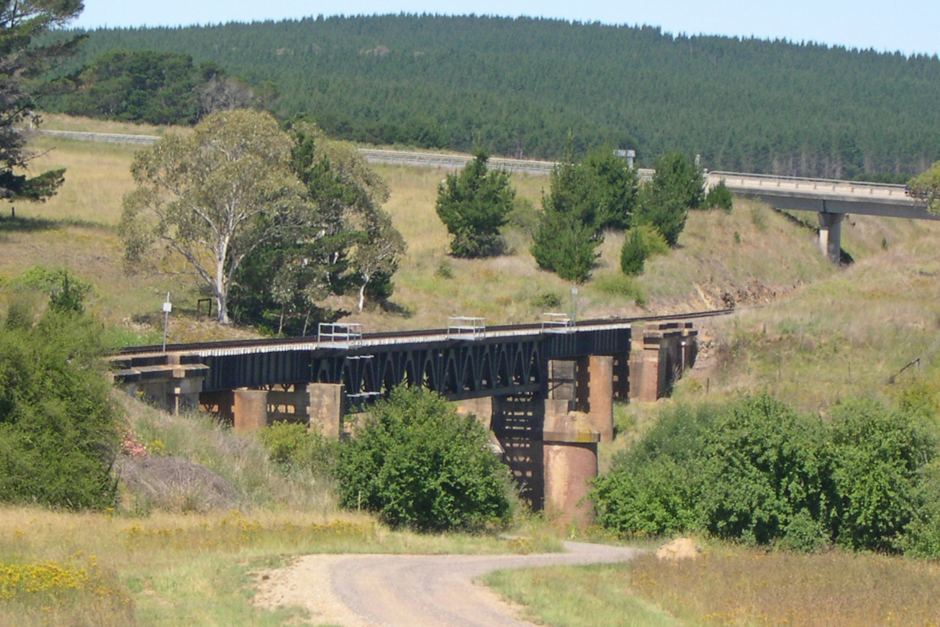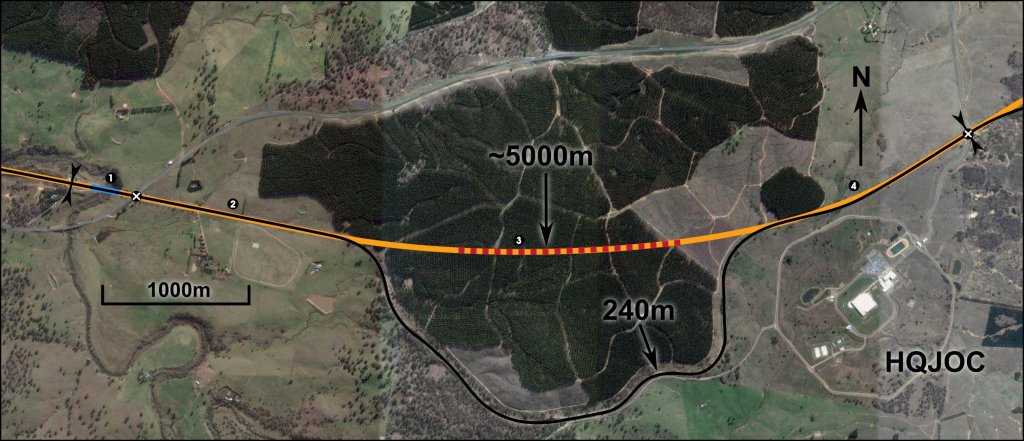This sector runs from the Burbong bridge over the Molonglo River, through the Kowen Forest pine plantation, finishing at the grade-separation over the driveway of the military installation Headquarters Joint Operation Command (HQJOC). The existing railway diverts around the southern edge of the plantation, with horizontal radius as tight as 240m. It is not feasible to achieve the desired minimum radius of 1000m while following this southerly diversion, so a new section of alignment through the forest is required. While expensive, this allows a radius of up to 5000m, and therefore future upgrade to speeds of 300km/h or greater.
Depending on the final vertical profile of the alignment, the cut will have to be up to 40m in depth, right on the limit of cost-competitiveness with tunnel. No land is required to be purchased, as the sector is entirely within Crown land. Vertical alignment is unproblematic, although the exceptional maximum gradient of 3% is reached in the second section.
Alignment Design
1 – Seventh Molonglo crossing

Looking east across Burbong bridge towards Kings Highway and Kowen Forest. Image: Clarissa Thorpe, ABC News.
Section length 430m, sector start. Consists of an approach to the existing Burbong Bridge, and then a shallow cut approaching the existing Kings Highway grade separation (rail under). Entire length on existing alignment. The single track bridge could be duplicated, upgraded or replaced entirely. The bridge pylons appear very sturdy for a single lane bridge; it may be possible to replace the existing deck with a dual track concrete deck whilst retaining the existing pylons; however for the purposes of this estimation we will assume a complete replacement of the bridge with dual track. Additionally, it is likely that the Kings Highway underbridge could be upgraded to dual width at substantially lower expense than complete replacement, however complete replacement will be assumed.
- Existing bridge is 130m in length with two main spans of span 27.5m (90ft) each. This allows commonality of infrastructure with the previous section. Five additional approach spans of 15m in length (3 on west and 2 on east side).
- Mainspan cost function = $16309/track-m
- = $1,794,000
- Approach spans cost function = 11725e0.012S = $11,938/track-m
- = $1,791,000
- Total bridge cost = $3,585,000 (new dual width)
- Mainspan cost function = $16309/track-m
- Remainder of section (300m) is shallow cut of approx. 4m depth. Requires widening to dual width (additional 6m): 6m×4m×300m = 7200m3
- Earthworks cost = $223,000
- Drainage @ $200k/km = $60,000
- Chainlink fence (both sides) = $30,000
- Whole length works:
- Upgrade 1 track, add 1 track: @$1.879m/km = $808,000
- Signalling & control: @$127k/km = $55,000
- Kings Highway underbridge: assume upgrade can be achieved for half cost of new major grade separation.
- Upgrade cost = $2,500,000
- Section cost = $7,261,000 ($16.89m/km)
2 – Kowen Forest approach
Section length 1400m starting at 430m. Consists of a duplication of the existing track, starting off in a shallow cut but mostly on a low embankment, and terminating where the new alignment diverges from the Kowen Forest curves. No crossings required.
- Earthworks:
- 300m cut widening, 4m deep: 7200m3, = $223,000
- Assume remainder of length is embankment of average height 3m: Volume = 1100×3×6 = 19800m3
- Fill @$16/m3, =$317,000
- Total earthworks cost = $540,000
- Whole length works:
- Upgrade 1 track, add 1 track: $2,631,000
- S&C = $318,000
- Drainage = $179,000
- Chainlink fence (both sides) = $140,000
- Section cost = $3,808,000 ($2.72m/km)
3 – Kowen Forest Cut
Section length 2830m starting at 1830m. Entirely new section consisting of a deep cutting, twice reaching a depth of 40m. As the cut is so long and variable in depth, we will analyse it in several distinct sections. A 1:1 slope will be assumed throughout, although geological survey may determine that a steeper cut may be possible. No agricultural crossings were assumed to be necessary; the southern section of forest can be accessed via a southerly route as the existing rail line will no longer be in use.
- Sectional cut analysis:
- 600m @ 5m = 51,000m3
- 300m @ 10m = 66,000m3
- 400m @ 35m = 658,000m3
- 350m @ 25m = 323,750m3
- 400m @ 35m = 658,000m3
- 780m @ 10m = 171,600m3
- Total 2830m length, 1,928,350m3 (!)
- Total cost = $59,779,000
- Whole length works:
- New dual track @$2.25m/km: $6,368,000
- Drainage: $566,000
- S&C: $359,000
- Chainlink fence (both sides): $283,000
- Section cost = $67,355,000 ($23.80m/km)
4 – HQJOC approach
Section length 1690m, starting at 4660m. Consists of a substantial fill, some on new alignment and some on existing, but all substantially similar to the existing alignment. Finishes with a duplication of the existing HQJOC rail overbridge. Due to the highly variable height of fill, the same piecewise approach will be taken as in the previous section. Although some existing alignment is re-used, the modifications to the track geometry mean entirely new track will be assumed for the section.
- Sectional fill analysis:
- 500m @ 5m (widening) = 15,000m3
- 700m @ 7.5m = 102,375m3
- 490m @ 3m (widening) = 8,820m3
- Total volume = 126,195m3
- Cost @$16/m3 = $2,019,000
- Whole length works
- Dual track = $3,803,000
- Drainage = $338,000
- Chainlink fence (both sides) = $169,000
- S&C = $215,000
- Duplication of HQJOC rail overbridge
- Length 40m, maximum span 20m
- Cost function 11725e0.012S = $14,905/track-m
- = $596,000
- Multiply by 1.67 (2 spans only) = $996,000
- Assume cost of $1m (compares well to assumption of $1.25m for minor grade separation).
- Section cost = $7,544,000 ($4.46m/km)
Optional tunnel (Section 3)
This option replaces the three deepest sections of the major cut with a dual-track, single-bore tunnel of outside diameter 12.4m, costing $62m/km. The length is 1150m.
- Modification to costs of section 3:
- Add tunnel cost of $71.3m
- Add tunnel excavation volume of 138,877m3
- Cut volume reduced by 1,639,750m3, cost reduced by $50,832,000
- General civil works cost reduced by $345,000 (no drainage or fencing required in tunnel)
- Modified section 3 cost = $87,478,000 ($30.91m/km)
Sector Summary
The total sector cost comes to $85,968,000, or $13.54m/km. The largest cost component is the very deep cutting, but there is no practical way to avoid this while retaining acceptable track geometry. The tunnel option in section 3 would be substantially more expensive, bringing the total sector cost to $103,791,000 ($16.35m/km). Which option is better?
The earthwork balance of the cut option is +1,796,755m3. That’s massive, the kind of number usually confined to digging a mine; if we dump it even a short distance from the excavation site, it will cost an additional $12.6m (wiping out a substantial part of the $20.1m difference between the cut and the tunnel options for section 3). The tunnel option would result in an earthwork balance of +295,882m3 – a large but manageable amount.
For this reason, the tunnel option shall be selected for this sector.
[table]
Component,Cost ($m),Percentage
Tunnel,69.0,52.2%
Bridge,3.6,3.5%
Earthworks,11.7,11.3%
Track,13.6,13.1%
Civil Works,4.9,4.7%
Signalling & Communications,0.9,0.9%
TOTAL,103.8,100%
[/table]





